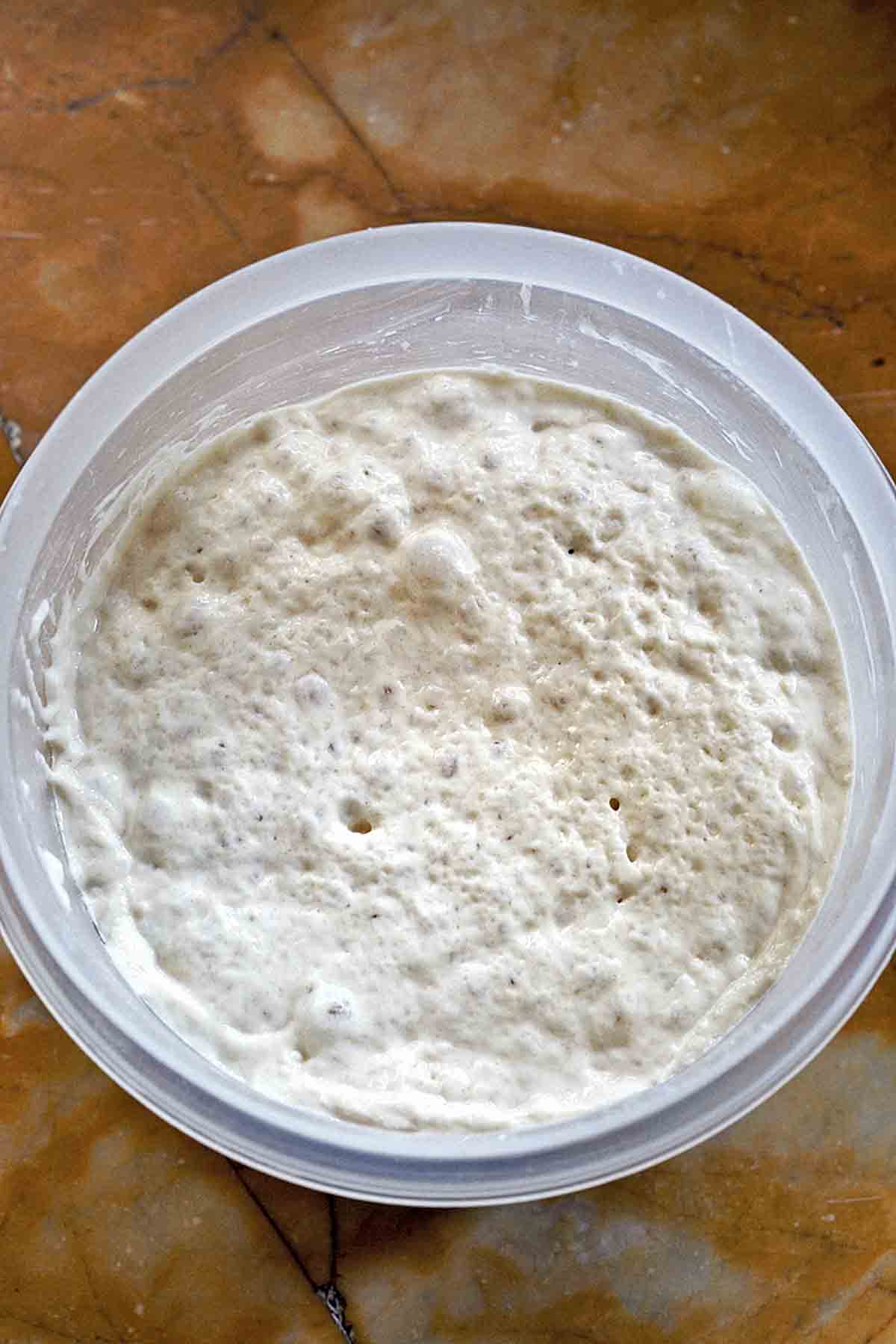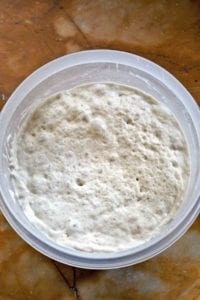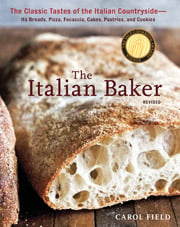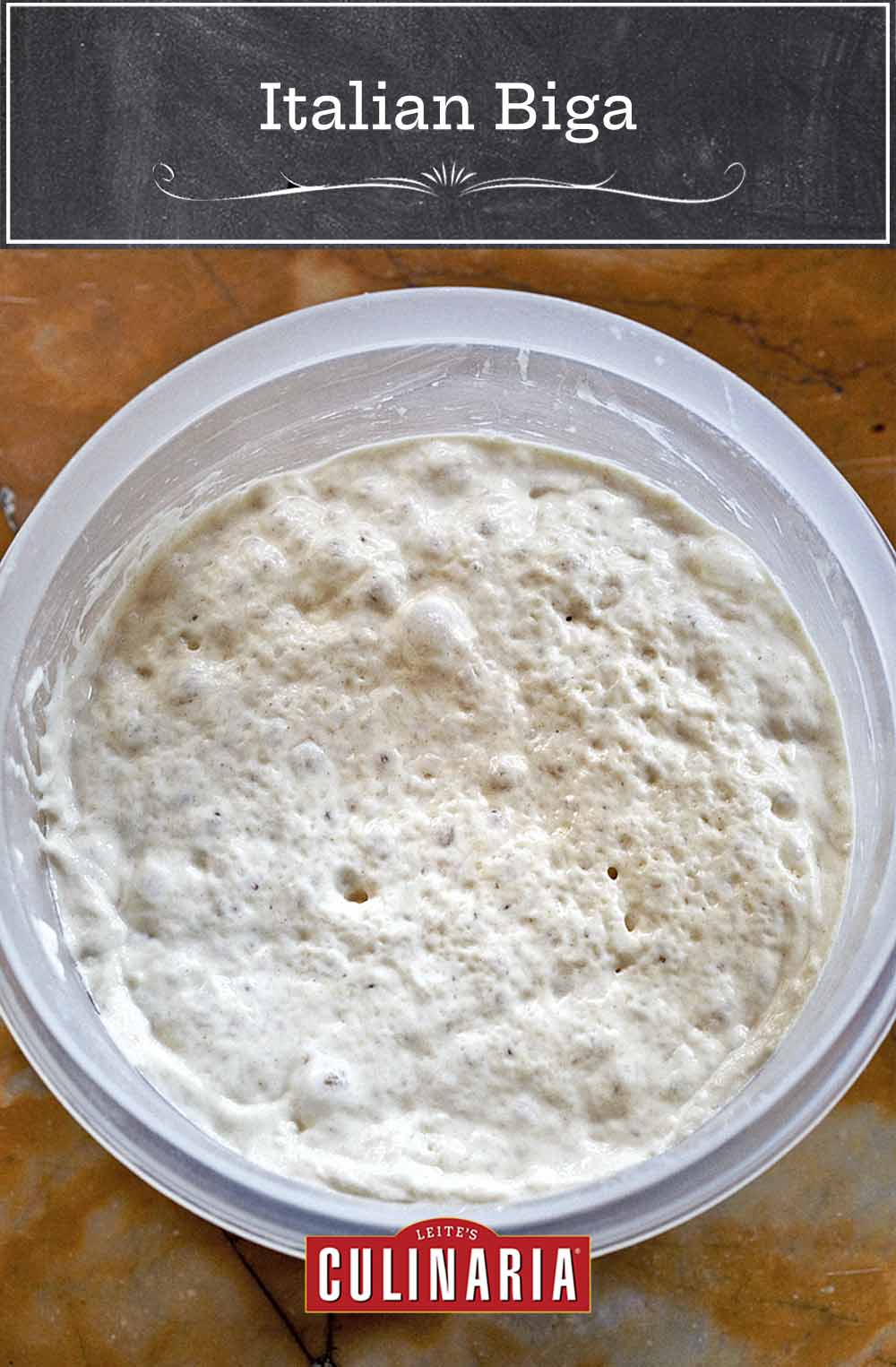
Many of the recipes for classic regional breads, such as this ciabatta recipe, begin with a starter dough made from small amounts of flour, water, and yeast allowed an initial fermentation. The starter, known as biga in Italy, or bighino when in small amounts, not only gives strength to what in Italy are weak flours, it also produces a secondary fermentation from which come the wonderful aroma, natural flavor, and special porosity of the final loaves and wheels of bread.
The important point about a biga is that the breads made with it develop a wonderful taste because their risings are long and bring out the flavor of the grain. Another benefit is that the loaves remain fresher and taste sweeter than those made with large amounts of commercial yeast.
In Italy, bakers use dough from the previous day’s baking to start a new dough. I keep some starter on hand at all times; by having it around, I can decide to make pane pugliese or ciabatta in the morning and have it for dinner that night. Because the first biga must come from somewhere, though, you may make it following the instructions below. It’s remarkable. It freezes very well and needs only about 3 hours at room temperature until it is bubbly and active again, or it can be refrigerated for up to 5 days.–Carol Field
LC Obliged to Biga Note
Behind each and every memorable bite of proper Italian bread we’ve daintily nibbled, hungrily inhaled, or otherwise somehow consumed, we have a biga to thank. So we’re feeling much obliged to Carol Field for this recipe. Nonna not included.

Italian Biga
Ingredients
- 1/4 teaspoon active dry yeast
- 1/4 cup warm water
- 3/4 cup plus 4 teaspoons water, preferably bottled spring water, at room temperature
- 2 1/3 cups unbleached all-purpose flour
- Vegetable oil, for the bowl
Instructions
- Stir the yeast into the 1/4 cup warm water and let stand until creamy, about 10 minutes.
- Stir the spring water into the creamy yeast mixture, and then stir in the flour, 1 cup at a time. If mixing by hand, stir with a wooden spoon for 3 to 4 minutes. If mixing with a stand mixer, beat with the paddle at the lowest speed for 2 minutes. If mixing with a food processor, mix just until a sticky dough forms.
- Transfer the biga to a lightly oiled bowl, cover with plastic wrap, and let rise at cool room temperature for 6 to 24 hours, until the starter is triple its original volume but is still wet and sticky. (The bakers I admire most advise 10 to 11 hours for the first rise, but others are very happy with the 24 hours it takes for dough to truly become yesterday’s dough, and if you like sour bread, allow your biga to rest for 24 to 48 hours or even 72 hours.)
- Cover and refrigerate or freeze the biga until ready to use. (If refrigerating the biga, use within 5 days. If freezing the biga, let it rest at room temperature for about 3 hours until it is bubbly and active again.) When needed, scoop out the desired amount of biga for your recipe and proceed. I strongly recommend weighing the biga rather than measuring it by volume since it expands at room temperature. If measuring by volume, measure chilled biga; if measuring by weight, the biga may be chilled or at room temperature.

Nutrition
Nutrition information is automatically calculated, so should only be used as an approximation.
Recipe Testers’ Reviews
This is a perfectly suitable starting point for most any bread which uses a starter. I bake bread several times a week and it’s nice to have this handy. Sometimes I add this to a bread dough which doesn’t call for a starter just for the added flavor.












Is it possible to refresh a biga, like you would a sourdough starter?
I suppose you could, Bob, but at some point you’d just end up with a sourdough starter, which has a different flavor.
Thanks Angie! I really couldn’t find a definitive anywhere else. So a non-sourdough biga would just be used within 3 – 5 days’ then you would just make another?
You’re welcome, Bob. Yes, you’d use it up within 3 to 5 days and make another or you freeze it for longer storage.
Hello, I’m having trouble understanding the percentage to use on my pizza dough when working with Biga. I’m making my dough with these percentages 100% flour 60% water, 3%salt , 1% oil, .25% yeast and 1% sugar. If I want to do that same percentage but using biga how would that change my percentage?
Hmm, that’s a little tricky, David. How much biga were you planning to use in the dough?
Angie,
I was looking at some videos and saw that the calculations sum up to 33% of biga of the 100% of the flour percentage. So I guess it would be 33% of biga? That I’ll be adding to my pizza recipe. Could that be right ?
I got the 33% from a recipe I saw in a video that the chef was mixing 18,000 gr of flour 100% 12,000 gr of water and 720gr of salt ( for his pizza recipe) for his biga recipe he had 6,000gr of flour 100% 3,000 of water 50% and 15gr of dry yeast.
David, 33% biga in your dough seems reasonable. Given that our biga flour to water ratio is similar to what you want to use in your dough, I think you can just make 1/3 of the total weight of your dough be biga. So if you are making 1000g of dough, then 330g would be the biga, and the remaining 670g would be the flour and water combination (400 g flour, 270 g water) plus the minor amounts of yeast, salt, and oil). Does that make sense?
Angie,
Thank you so much for all the help. Helped clear up a lot of questions with the biga process. I’ve been using the method two times already for my pizza dough and they are coming out great.
Wonderful, David. That’s so great to hear. Can’t wait to hear what you try next.
Hey Angie, I’m
Back again just to clear things up. Like I said I was using a 33% biga, but I think I was doing it wrong after adding the other ingredients at the mixing process. If I understand correctly, when I take the 33% of my 100% flour to start the biga ( example; 6,726gr of flour, the 33% of that is 2,220gr of flour for the biga and the 50%of that is 1,110gr of water and .25% of yeast is 6 gr. that’s to finish my biga) after waiting for the fermentation and adding my remaining ingredients to the mixing process. Do I just subtract what I already used in making the biga to the over all recipe ?
Hi David. Yes, that’s correct. Subtract what you already used and then make the dough with the remaining amounts.
Angie, For a traditional Italian bread loaf, what percentage of the biga do use in correspondence to the flour amount of that bread recipe ? ie, if you’re going to use 16 ounces of flour, how many ounces of biga do you add? Is the biga percentage just of the flour or of the whole weight of the recipe with all the other ingredients combined, mostly the water weight? Plz\Thxs
Kevin, I don’t have a lot of experience with biga loaves, but my understanding is that it can vary depending on the type of bread. For a traditional loaf, I think you’d use about 40% of the weight of the flour you are using in the bread. So if your bread uses 16 ounces of flour, then you’d add 6.4 ounces of biga. There’s definitely room to play around with it, and I’ve seen recipes with as little as 20% biga or as 100% of the flour weight, but the more you add, the more holes you’ll have. The dough will also become wetter and more difficult to work with. I’d start with 40% and see how it goes.